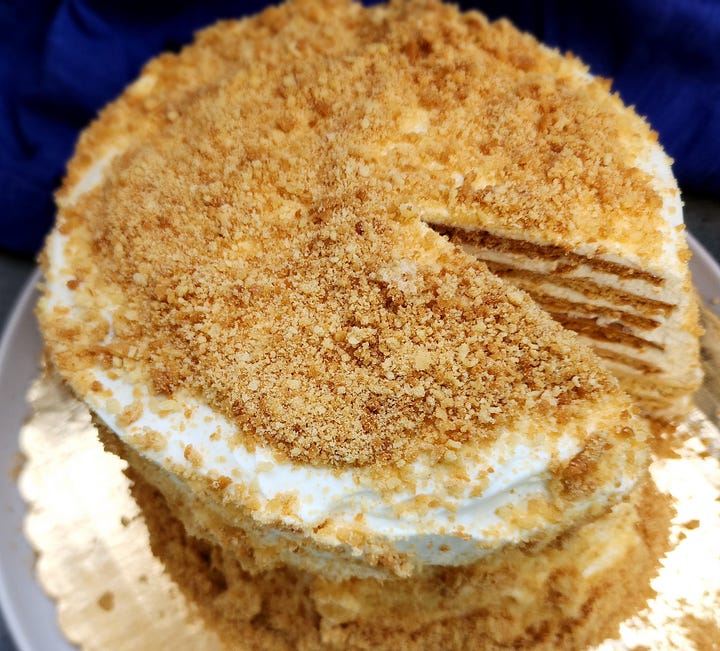Solid Recipes, Struggling Country: "The Authentic Ukrainian Kitchen"
The Authentic Ukrainian Kitchen: Recipes from a Native Chef
How should a non-native cookbook reviewer approach a book about another country’s cuisine?
That question kept coming up in recipe testing of The Authentic Ukrainian Kitchen: While there was much here to like, was it the fault of the recipe or the reviewer when a dish didn’t appeal?
Author Yevhen Klopotenko is a chef and restaurateur with an impressive history: Winner of MasterChef Ukraine in 2015, he has championed traditional Ukrainian foods—deeply threatened and hidden under years of Soviet control—and led a project to improve school meals, working with Ukraine’s first lady. His commitment to his homeland and its defenders as Russia attacks it yet again will make readers want to love this book.
And for the most part, they will.
Recipes usually stick to one page—often taking up far less—with accommodations made for hard-to-find ingredients, making them feel eminently doable. Each recipe’s headnote provides useful context on its history, plus tweaks Klopotenko has made to traditional recipes or suggestions for variations.
Appealing, simple dishes include handheld meat pies; sausages in deep-fried pastry; quick-pickled apples; Ukrainian sauerkraut; pumpkin porridge with millet; cucumber, mint, and celery salad; borsch with pork ribs and smoked pears; sweet and savory boiled or steamed dumplings; crisp potato pancakes; cherry torte; honey layer cake; and a traditional dried-fruit drink that Klopotenko spikes with honey and smoked pepper.
What readers won’t find, for the most part, are sock-it-to-you flavors. Thus that question—if these are, in fact, truly traditional, barely tweaked versions of authentic Ukrainian food, is bland a fault? Or just a problem of one person’s palate expectations?
The honey layer cake, for example, presents a pretty picture (if you can get it to stand tall—as the hastily taken photos make clear!). Made with a stiff dough rolled into seven thin layers, each baked and stacked with a thin coating of sour cream frosting, the cake lacked a distinctive honey flavor, with just three tablespoons in the batter and none in the frosting. To American tastes, it will seem to be missing vanilla or another spice. And it was somewhat dry even after an overnight chill to allow the cake to absorb some of the frosting—but many European cakes seem dry to American tastes, such as some German and Austrian tortes.


The Lviv cheesecake provoked a similar response—drier than American-style cheesecakes given its filling of farmer cheese and, interestingly, grated or riced cooked potatoes, and lacking a strong central flavor, despite a filling that included some chopped dried apricots and a dark chocolate glaze. The bland cheesecake could have held more interest with a teaspoon or two of vanilla or almond extract or a good soak of the apricots in rum, but, presumably, would then have failed the authenticity test.
An easy cherry torte with walnuts, on the other hand, provided more than it promised: With just eggs, sugar, a whisper of vanilla, a few dry ingredients, and walnuts and cherries, this torte’s crisp, caramelized top crust and juicy cherries offered stronger flavor and pleasing texture.
That felt like an exception, though, as more tepid flavors followed in recipe tests: The simple quick-pickled apple used such a low proportion of vinegar that it would have seemed a typo were it not for the quiet flavors throughout the book. Calling for just ¼ cup apple cider vinegar to ¼ cup sugar and 6 to 8 cups of water, the apples—meant to be eaten alongside meat or in salads—offered at most a mild flavor gently spiked with garlic and whiffs of allspice and pepper. Hand pies made with a simple yeast dough enclosing a minced pork shoulder filling similarly offered muted flavors, with just a touch of bay and allspice.
But, finally, what about borsch? If you think of anything when you think of Ukrainian specialties, this is it—and the pork rib version, one of three borsch offerings, came through with much more flavor and texture than it first appeared.
Unlike many in the book, this recipe didn’t come together in a flash for a weeknight supper. But its strong base of pork ribs, cubes of celery root, carrots, pepper, tomatoes, potatoes, white beans, cabbage, shredded beets, and smoked paprika (Klotopenko’s suggested alternative to smoked pears or prunes) could be—really, should be—cooked well ahead. At the end of cooking, the broth looked and tasted thin, despite all the vegetables and pork. But a day later, the flavors had blended and deepened, with textures to match.
Waffling reviews leave readers wishing for a simple yea or nay—buy/don’t buy? This one waffles more than most, but ultimately, yea. Because the recipes seem generally solid, tweaking to taste—more bay! more pepper! more allspice! some (any) vanilla, cardamom, ginger, or almond!—should be both possible and fun, to personalize flavors while honoring a cuisine, and a country, under unwarranted, undeserved, and unconscionable duress.
Quick takes:
The Authentic Ukrainian Kitchen: Recipes from a Native Chef, by Yevhen Klopotenko. 269 pages. Published by Voracious/Little, Brown and Company.
Photos: Photos with every recipe (this is a niche observation, but if you/your mother/your grandmother had 1980s-era Southern Living magazine annual recipe compilation cookbooks, these photos will look familiar—it’s something about the slightly dark lighting, often very blurred backgrounds, and food styling…which may come as a relief after the sameness of many current cookbooks’ faux rusticity or harsh color saturation.)
Organization: Chapters for breads/dips, appetizers, breakfast, salads, soup/borsch, main dishes, sweets, and drinks.
Index: Comprehensive.
Disclosure: I am an affiliate of Bookshop.org, which supports independent booksellers, and I will earn a commission if you click through and make a purchase on the title above.
The Spice of Life
Everything is better with Pepper
Pepper wards off her own invasion. (Fuzzy pic #3 today!)
.




